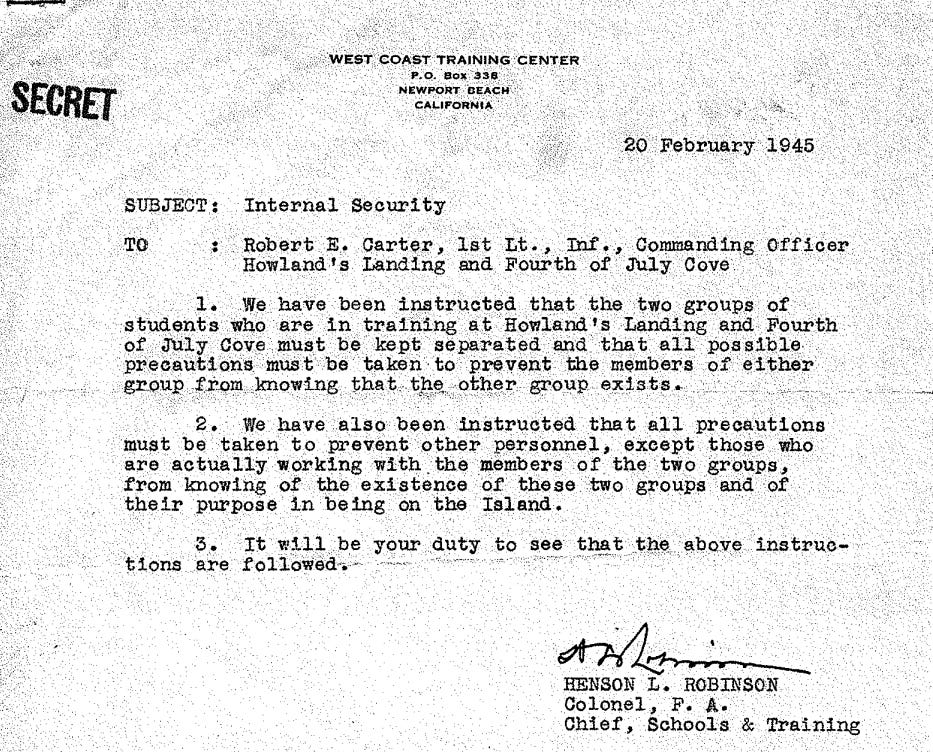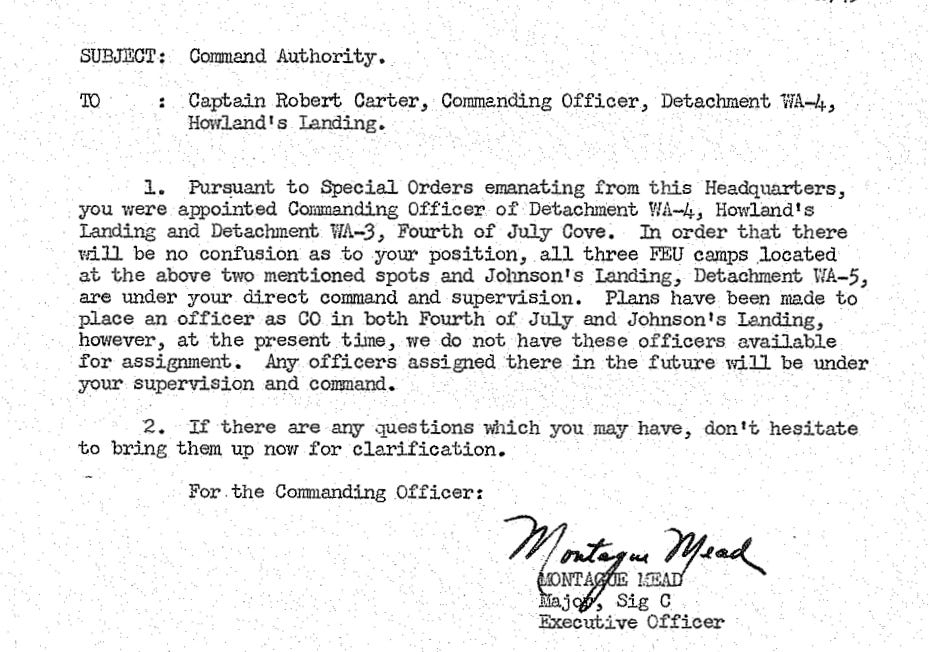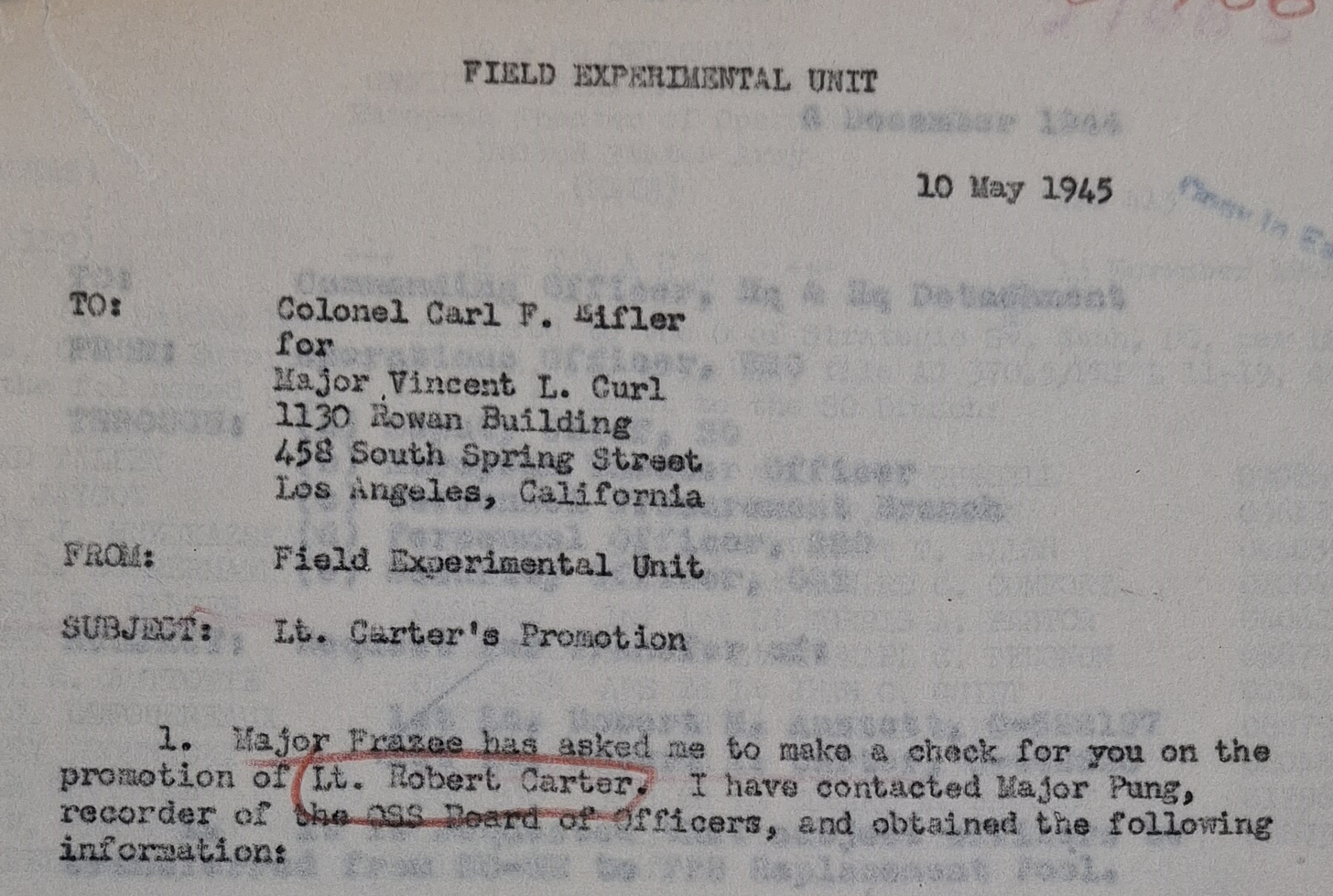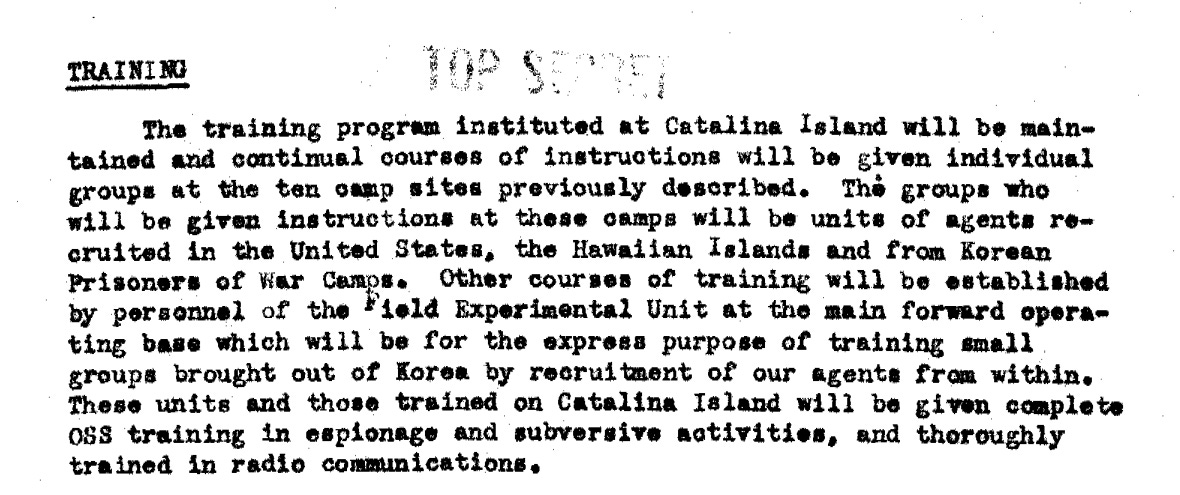The Commanding Officer
Robert Carter's classified OSS orders provide further evidence that Project NAPKO was a cover operation
Moon Duck Harr, an OSS agent whose name, I believe, is a pseudonym for Karl Harr, Jay’s cousin, appears in his OSS personnel file to be one of a group of Korean agents who trained on Santa Catalina Island, off the coast of California, during the spring and summer of 1945.
Looks, however, can be deceiving.
In an attempt to determine whether or not this agent was training in preparation for a role in Operation NAPKO, I carefully reviewed the documentary record pertaining to Robert Edward Carter, the commanding officer for two of the training sites.
A source with access to Carter’s classified orders provided me with unredacted copies of those documents. This article draws from those 21 pages, as well as from Carter’s 62-page personnel file, which was declassified in 2008.
Background
Robert Carter was a recent graduate of Davidson College in North Carolina when he entered the army in 1942. He was born in 1919 in Alexandria, Virginia, and by the time he served under Carl Eifler, he stood 6’3” and weighed 170 lbs.
Carter was outside the country for only 4 out of his 42 months in the military, but that doesn’t mean he was bored. Far from it.
Carter completed 17 weeks of rifle and heavy weapons training at Fort Benning, in Georgia. He also did four weeks of army parachute training there. Later, after he joined the OSS, Carter completed four additional weeks of parachute training at the OSS school in England.
Training for Project NAPKO
Carter received his first set of orders related to Catalina Island on January 24, 1945.
Alongside Harry E. Russell, Carter was ordered to report to the West Coast Training Center at Newport Beach, California.
At Newport Beach on February 3, Captain H.K. Lenocker appointed Carter the commanding officer of WA-3 and WA-4, two training sites on Catalina Island.
In a letter dated February 20, 1945, Col. Henson L. Robinson, Chief of Schools & Training, stressed the importance of security and compartmentalization. Each training group was to be kept separate from the others, such that students in each group should be completely unaware of other student groups on the island.
In fact, the mere existence of the two groups was to be kept secret from everyone not directly training them.
This letter is also important because it confirms in plain writing that Carter’s two groups were trained at Howland’s Landing and Fourth of July Cove.
What I find curious is the choice of Carter to lead the training. Carter was well trained and by all indications a fine soldier and OSS officer, but nothing in his records suggests that he had expertise in maritime operations like the one Carl Eifler had apparently conceived (Project NAPKO), and for which Carter was to train the groups of Koreans.
Carter had eight weeks of parachute training. We know that Hugh Tovar, who would later serve as CIA station chief in four different Southeast Asian countries before rising to the top of the Counterintelligence staff, trained on Catalina Island in the summer of 1945. He parachuted into Laos that fall.
I think Karl Harr was sent on a similar mission, maybe to the same section of Indochina. Both men spoke French.
But did Karl parachute in? His trip to Nassau in February 1946 suggests that he had some ties to the OSS’s Maritime Unit, which had a large base there (as well as on Catalina Island).
Might there have been both land and sea components to whatever was afoot in the summer of 1945 under EIfler’s watchful eye?
Perhaps.
Carl Eifler had been moved from Special Operations to Special Projects, which was an interdisciplinary role.
It would make sense if Robert Carter held command over the two previously mentioned sites, as well as Toyon Cove, with the first two acting as a diversion for what was going on at the third site.
A letter sent on June 12, 1945, by Major Montague Mead, an Executive Officer in something called “Sig C” (Signal Corps would make sense, but the OSS was not known to have had a separate signals intelligence unit), spoke of three sites under Carter’s command.
But the third site was Johnson’s Landing (WA-5), not Toyon Cove.
Mead also wrote of an intention to provide Fourth of July Cove and Johnson’s Landing with their own commanding officers, both of whom would report to Carter.
At the time, though, there were no such officers available.
Carter’s next order arrived on September 25, 1945, calling on him to return to OSS headquarters in Washington, D.C.
My source, who met Robert Carter before his death and spoke with him about his time in the OSS, told me that Carter was preparing to join his students on the mission for which he was training them.
However, the mission never went forward, and Robert Carter was discharged from active duty on January 4, 1946.
A clue in Carter’s personnel file
A letter to Carl Eifler, sent on May 10, 1945, reveals that Robert Carter was up for a promotion, but that a paperwork snafu was holding up the formal acceptance.
An important piece of metadata is the address at which Eifler was located: 450 South Spring Street in Los Angeles.
So, in the spring of 1945, Eifler was on the mainland, but close enough to oversee training on Catalina Island.
Meanwhile, Robert Carter had done something significant enough in his three months leading the training for NAPKO to merit a promotion.
Sorting through discrepancies
A key passage from Carl Eifler’s Project NAPKO plan is found on page 64.
There he notes that recruits will come from the United States, the Hawaiian Islands and from Korean Prisoners of War Camps.
Other courses of training will be established by personnel of the Field Experimental Unit at the main forward operating base which will be for the express purpose of training small groups brought out of Korea by recruitment of our agents from within.
Training at the forward operating base for agents recruited, presumably by the initial wave of NAPKO agents, raises the possibility of “train the trainer” activities on Catalina Island.
But, what if we presume nothing?
We know that some NAPKO agents were American, but the plan does not say the recruits would be brought out of Korea by NAPKO agents. It only says that their training at the forward operating base would be part of NAPKO.
The NAPKO planning document offers nothing concrete about who would do the recruiting and how the recruits would get to the base. In fact, Eifler does not even say that the recruits would be Korean, only that they would come from Korea.
Conclusions
Needless to say, this is all very confusing.
Here is what we can conclude with a high degree of confidence:
Col. Carl Eifler was running a special project that involved Project NAPKO, a plan to land agents along the Korean coast via mini submersible vehicles deployed from submarines.
Major Vincent Curl managed student training for Eifler’s project on Catalina Island.
Lt. Robert Carter, who reported directly to Curl, commanded three schools on Catalina Island. Howland’s Landing and Fourth of July Cove were the main sites training students for Project NAPKO. A third site, which Carter told my source was smaller and closed before the other two, may have been where training was conducted for those designated to train new agents exfiltrated from Korea at a forward operating base.
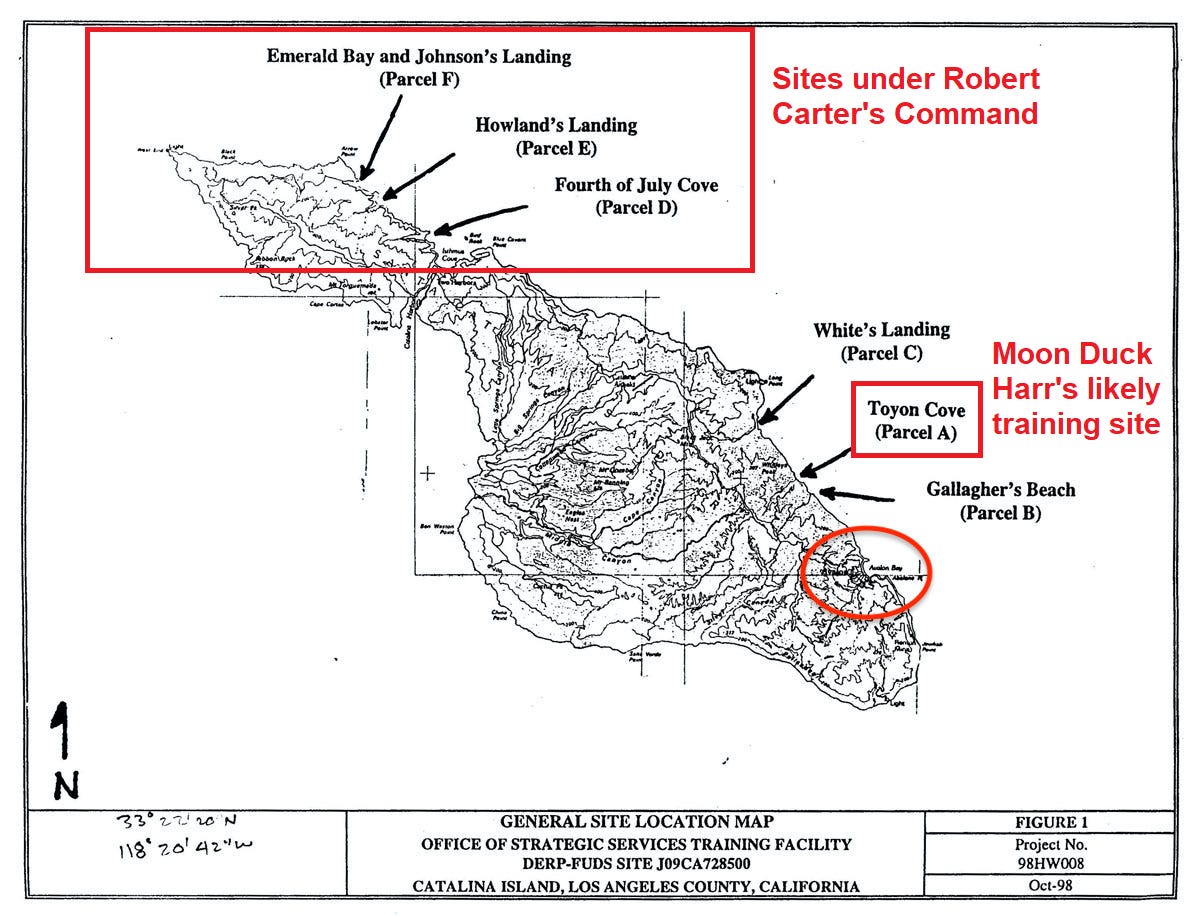
Toyon Cove is geographically separated from the three training sites under Robert Carter’s command. It was also the main training school on the island. (Source) Lt. Harry Russell, another OSS officer, was ordered to report to the Newport Beach training site alongside Carter in January 1945.
Hugh Tovar was part of a group of students who trained on Catalina Island in the summer of 1945, likely at the main training site (Toyon Cove), then parachuted into China or Indochina. Only partial records of Tovar’s training are included in his OSS personnel file. An agent profile in the name Bernard H. Trygstad, which likely rolls up to Tovar, does not mention training. Tovar’s full training record is likely hiding under another pseudonym, which may or may not be a Korean sounding name.
Karl Harr was lucky to survive an airplane crash between Hawaii and the continental United States in November 1945. Harr was probably returning from the China-Burma-India theater. Hugh Tovar was returning home from that same theater at the same time.
From these data points, it appears that Carl Eifler was running a special project at the end of the war that included a decoy component (Project NAPKO). The real operation may have been the one Hugh Tovar has spoken publicly about - it was aimed at finding and rescuing downed allied pilots.
Harry Russell is a logical candidate for the commanding officer of this secret group. Conclusive evidence may or may not lie within his personnel file, which is housed at the National Archives in College Park, Maryland.
Incidentally, this is the sort of operation that was right in Eifler’s wheel-house. It appears to have been a redux of the Detachment 101 operation he led two years prior, only with Eifler commanding from his post at Newport Beach, California.
And this one was more successful.




